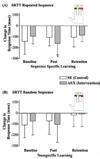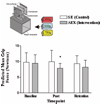Aerobic exercise improves cognition and motor function poststroke
- PMID: 19541916
- PMCID: PMC3024242
- DOI: 10.1177/1545968309338193
Aerobic exercise improves cognition and motor function poststroke
Abstract
Background: Cognitive deficits impede stroke recovery. Aerobic exercise (AEX) improves cognitive executive function (EF) processes in healthy individuals, although the learning benefits after stroke are unknown.
Objective: To understand AEX-induced improvements in EF, motor learning, and mobility poststroke.
Methods: Following cardiorespiratory testing, 38 chronic stroke survivors were randomized to 2 different groups that exercised 3 times a week (45-minute sessions) for 8 weeks. The AEX group (n = 19; 9 women; 10 men; 64.10 +/- 12.30 years) performed progressive resistive stationary bicycle training at 70% maximal heart rate, whereas the Stretching Exercise (SE) group (n = 19; 12 women; 7 men; 58.96 +/- 14.68 years) performed stretches at home. Between-group comparisons were performed on the change in performance at "Post" and "Retention" (8 weeks later) for neuropsychological and motor function measures.
Results: VO(2)max significantly improved at Post with AEX (P = .04). AEX also improved motor learning in the less-affected hand, with large effect sizes (Cohen's d calculation). Specifically, AEX significantly improved information processing speed on the serial reaction time task (SRTT; ie, "procedural motor learning") compared with the SE group at Post (P = .024), but not at Retention. Also, at Post (P = .038), AEX significantly improved predictive force accuracy for a precision grip task requiring attention and conditional motor learning of visual cues. Ambulation and sit-to-stand transfers were significantly faster in the AEX group at Post (P = .038), with balance control significantly improved at Retention (P = .041). EF measurements were not significantly different for the AEX group.
Conclusion: AEX improved mobility and selected cognitive domains related to motor learning, which enhances sensorimotor control after stroke.
Figures


References
-
- Haring HP. Cognitive impairment after stroke. Curr Opin Neurol. 2002;15:79–84. - PubMed
-
- Hofgren C, Björkdahl A, Esbjörnsson E, Sunnerhagen KS. Recovery after stroke: cognition, ADL function and return to work. Acta Neurol Scand. 2007;115:73–80. - PubMed
-
- Stephens S, Kenny RA, Rowan E, et al. Neuropsychological characteristics of mild vascular cognitive impairment and dementia after stroke. Int J Geriatr Psychiatry. 2004;19:1053–1057. - PubMed
-
- Barko-Collo S, Feigin V. The impact of neuropsychological deficits on function stroke outcomes. Neuropsychol Rev. 2006;16:53–64. - PubMed
-
- Zinn S, Bosworth HB, Hoenigh HM, Swartzwelder HS. Executive function deficits in acute stroke. Arch Phys Med Rehabil. 2007;88:173–180. - PubMed

